NMR, FT-IR, XRD, SEM, and ANN Complex Characterization of Some Nonwoven Materials Produced by Electrospinning
Highlights
- Electrospun nanofiber films were produced from natural and artificial materials.
- Raw materials, solutions and final nanofiber films were well characterized.
- Briefly 1D and 2D 1H Nuclear Magnetic Resonance revealed multiple dynamic components.
- Scanning electron microscopy images were combined with an Artificial Neural Network.
- The local order degree ranges of one and two component nanofiber films were evaluated.
Abstract
1. Introduction
2. Materials and Methods
2.1. Materials
2.2. Electrospinning
2.3. X-Ray Diffraction
2.4. 1H NMR Relaxometry
2.5. 1H NMR Spectroscopy
2.6. FT-IR Spectroscopy
2.7. Scanning Electron Microscopy
2.8. Artificial Neural Network Analysis
3. Results and Discussions
3.1. Characterization of Raw Materials
3.1.1. Crystallin to Amorphous Character Evaluated from XRD Characterization
3.1.2. Structural and Dynamics Characterization by FT-IR Spectroscopy and 1H NMR Relaxometry
3.2. Characterization of Electrospun Solutions
3.2.1. Complex Interactions in Electrospun Solutions Evaluated from High-Field 1H NMR Spectroscopy
3.2.2. Molecular Dynamics of Liquid Solutions Evaluated by Low-Field 1H NMR Relaxometry
3.2.3. FT-IR Spectroscopy of Mono- and Two-Component Electrospun Solutions
3.3. Characterization of Electrospun Nonwoven Films
3.3.1. Surface Area, Porosity, and Nanofibers’ Network Hierarchy Evaluated by SEM
3.3.2. Structural Characterization by FT-IR Spectroscopy
3.3.3. Polymer Network Dynamics Evaluated by Low-Field 1H NMR Relaxometry
3.3.4. Molecular Exchange Evaluated from 1H NMR T2-T2 EXSY Maps
3.3.5. Application and Machine Learning for the Characterization of the Orientation of Bio-Nanofibers
4. Discussions and Perspectives
5. Conclusions
Author Contributions
Funding
Institutional Review Board Statement
Informed Consent Statement
Data Availability Statement
Conflicts of Interest
References
- Yarin, A.L.; Koombhongse, S.; Reneker, D.H. Bending instability in electrospinning of nanofibers. J. Appl. Phys. 2001, 89, 3018–3026. [Google Scholar] [CrossRef]
- Ramakrishna, S.; Fujihara, K.; Teo, W.E.; Yong, T.; Ma, Z.; Ramaseshan, R. Electrospun nanofibers: Solving global issues. Mater. Today 2006, 9, 40–50. [Google Scholar] [CrossRef]
- Smith, L.A.; Ma, P.X. Nano-fibrous scaffolds for tissue engineering. Coll. Surf. B 2004, 39, 125–131. [Google Scholar] [CrossRef]
- Crainic, R.; Farcașanu, A.S.; Pășcuță, P.; Șaitiș, L.D.; Popa, F.; Fechete, R. Complex characterization of nanofibers biomaterials based on chitosan, collagen and fish gelatin produced by electrospinning. Anal. Lett. 2025, 58, 1822–1850. [Google Scholar] [CrossRef]
- Ribeiro, S.; Ribeiro, T.; Ribeiro, C.; Correia, D.; Farinha, J.; Gomes, A.; Baleizão, C.; Lanceros-Méndez, S. Multifunctional platform based on electroactive polymers and silica nanoparticles for tissue engineering applications. Nanomaterials 2018, 8, 933. [Google Scholar] [CrossRef] [PubMed]
- Yoon, J.; Yang, H.S.; Lee, B.S.; Yu, W.R. Recent progress in coaxial electrospinning: New parameters, various structures, and wide applications. Adv. Mater. 2018, 30, 1704765. [Google Scholar] [CrossRef] [PubMed]
- Mendes, A.C.; Stephansen, K.; Chronakis, I.S. Electrospinning of food proteins and polysaccharides. Food Hydrocoll. 2017, 68, 53–68. [Google Scholar] [CrossRef]
- Xue, J.; Wu, T.; Dai, Y.; Xia, Y. Electrospinning and electrospun nanofibers: Methods, materials, and applications. Chem. Rev. 2019, 119, 5298–5415. [Google Scholar] [CrossRef]
- Mostafa, N.Z.; Talwar, R.; Shahin, M.; Unsworth, L.D.; Major, P.W.; Doschak, M.R. Cleft palate reconstruction using collagen and nanofiber scaffold incorporating bone morphogenetic protein in rats. Tissue Eng. Part A 2015, 21, 85–95. [Google Scholar] [CrossRef]
- Nune, S.K.; Rama, K.S.; Dirisala, V.R.; Chavali, M.Y. Electrospinning of collagen nanofiber scaffolds for tissue repair and regeneration. In Nanostructures for Novel Therapy; Elsevier: Amsterdam, The Netherlands, 2017; pp. 281–311. [Google Scholar]
- Almeida, L.R.; Martins, A.R.; Fernandes, E.M.; Oliveira, M.B.; Correlo, V.M.; Pashkuleva, I.; Marques, A.P.; Ribeiro, A.S.; Durães, N.F.; Silva, C.J. New biotextiles for tissue engineering: Development, characterization and in vitro cellular viability. Acta Biomater. 2013, 9, 8167–8181. [Google Scholar] [CrossRef]
- Yilmaz Atay, H. Antibacterial activity of chitosan-based systems. In Functional Chitosan: Drug Delivery and Biomedical Applications; Springer: Singapore, 2020; Volume 6, pp. 457–489. [Google Scholar]
- Feng, P.; Luo, Y.; Ke, C.; Qiu, H.; Wang, W.; Zhu, Y.; Hou, R.; Xu, L.; Wu, S. Chitosan-based functional materials for skin wound repair: Mechanisms and applications. Front. Bioeng. Biotech. 2021, 9, 650598. [Google Scholar] [CrossRef]
- Kong, M.; Chen, X.G.; Xing, K.; Park, H.J. Antimicrobial properties of chitosan and mode of action: A state of the art review. Int. J. Food Microbio. 2010, 144, 51–63. [Google Scholar] [CrossRef] [PubMed]
- Rabea, E.I.; Badawy, M.E.-T.; Stevens, C.V.; Smagghe, G.; Steurbaut, W. Chitosan as antimicrobial agent: Applications and mode of action. Biomacromolecules 2003, 4, 1457–1465. [Google Scholar] [CrossRef] [PubMed]
- Chen, Z.; Mo, X.; Qing, F. Electrospinning of collagen–chitosan complex. Mater. Lett. 2007, 61, 3490–3494. [Google Scholar] [CrossRef]
- de Farias, B.S.; Christ Ribeiro, A.; Jaeschke, D.P.; Ribeiro, E.S.; Gonçalves, J.O.; Vergara, R.F.; Fernandes, S.S.; Dias, D.; Cadaval, T.R.S., Jr.; de Almeida Pinto, L.A. Recent Trends in Gelatin Electrospun Nanofibers: Advances in Fabrication, Functionalization, and Applications. Coatings 2025, 15, 1110. [Google Scholar] [CrossRef]
- Su, X.N.; Khan, M.F.; Xin-Ai; Liu, D.L.; Liu, X.F.; Zhao, Q.L.; Cheong, K.L.; Zhong, S.Y.; Li, R. Fabrication, Modification, Interaction Mechanisms, and Applications of Fish Gelatin: A Comprehensive Review. Int. J. Biol. Macromol. 2025, 288, 138723. [Google Scholar] [CrossRef]
- Silva, R.S.G.; Bandeira, S.F.; Pinto, L.A.A. Characteristics and Chemical Composition of Skins Gelatin from Cobia (Rachycentron canadum). LWT 2014, 57, 580–585. [Google Scholar] [CrossRef]
- Haug, I.J.; Draget, K.I.; Smidsrød, O. Physical and Rheological Properties of Fish Gelatin Compared to Mammalian Gelatin. Food Hydrocoll. 2004, 18, 203–213. [Google Scholar] [CrossRef]
- Kwak, H.W.; Shin, M.; Lee, J.Y.; Yun, H.; Song, D.W.; Yang, Y.; Shin, B.S.; Park, Y.H.; Lee, K.H. Fabrication of an Ultrafine Fish Gelatin Nanofibrous Web from an Aqueous Solution by Electrospinning. Int. J. Biol. Macromol. 2017, 102, 1092–1103. [Google Scholar] [CrossRef]
- Liu, X.; Ma, P.X. Polymeric scaffolds for bone tissue engineering: On musculoskeletal bioengineering. Ann. Biomed. Eng. 2004, 32, 477–486. [Google Scholar] [CrossRef]
- Stevens, M.M. Biomaterials for bone tissue engineering. Mater. Today 2008, 11, 18–25. [Google Scholar] [CrossRef]
- Naveena, N.; Venugopal, J.; Rajeswari, R.; Sundarrajan, S.; Sridhar, R.; Shayanti, M.; Narayanan, S.; Ramakrishna, S. Biomimetic composites and stem cells interaction for bone and cartilage tissue regeneration. J. Mater. Chem. 2012, 22, 5239–5253. [Google Scholar] [CrossRef]
- Li, H.; Xia, Y.; Wu, J.; He, Q.; Zhou, X.; Lu, G.; Shang, L.; Boey, F.; Venkatraman, S.S.; Zhang, H. Surface modification of smooth poly(L-lactic acid) films for gelatin immobilization. ACS Appl. Mater. Interfaces 2012, 4, 687–693. [Google Scholar] [CrossRef] [PubMed]
- Sui, G.; Yang, X.; Mei, F.; Hu, X.; Chen, G.; Deng, X.; Ryu, S. Poly-L-lactic acid/hydroxyapatite hybrid membrane for bone tissue regeneration. J. Biomed. Mater. Res. A 2007, 82, 445–454. [Google Scholar] [CrossRef] [PubMed]
- Woodruff, M.A.; Hutmacher, D.W. The return of a forgotten polymer—Polycaprolactone in the 21st century. Prog. Polym. Sci. 2010, 35, 1217–1256. [Google Scholar] [CrossRef]
- Böstman, O.M.; Pihlajamäki, H.K. Adverse tissue reactions to bioabsorbable fixation devices. Clin. Orthop. Relat. Res. 2000, 371, 216–227. [Google Scholar] [CrossRef]
- Sung, H.; Meredith, C.; Johnson, C.; Galis, Z.S. The effect of scaffold degradation rate on three-dimensional cell growth and angiogenesis. Biomaterials 2004, 25, 5735–5742. [Google Scholar] [CrossRef]
- Kim, H.; Panda, P.K.; Sadeghi, K.; Seo, J. Poly(vinyl alcohol)/hydrothermally treated tannic acid composite films as sustainable antioxidant and barrier packaging materials. Prog. Org. Coat. 2023, 174, 107305. [Google Scholar] [CrossRef]
- Huang, C.-Y.; Hu, K.-H.; Wei, Z.-H. Comparison of cell behavior on PVA/PVA–gelatin electrospun nanofibers with random and aligned configuration. Sci. Rep. 2016, 6, 37960. [Google Scholar] [CrossRef]
- Koosha, M.; Mirzadeh, H. Electrospinning, mechanical properties, and cell behavior study of chitosan/PVA nanofibers. J. Biomed. Mater. Res. A 2015, 103, 3081–3093. [Google Scholar] [CrossRef]
- Panda, P.K.; Park, K.; Seo, J. Development of poly(vinyl alcohol)/regenerated chitosan blend film with superior barrier, antioxidant, and antibacterial properties. Prog. Org. Coat. 2023, 183, 107749. [Google Scholar] [CrossRef]
- Ahmed, F.E.; Lalia, B.S.; Hashaikeh, R. A review on electrospinning for membrane fabrication: Challenges and applications. Desalination 2015, 356, 15–30. [Google Scholar] [CrossRef]
- Hendrick, E.; Frey, M. Increasing surface hydrophilicity in poly(lactic acid) electrospun fibers by addition of PLA-b-PEG copolymers. J. Eng. Fiber Fabr. 2014, 9, 153–164. [Google Scholar] [CrossRef]
- Lins, L.C.; Wianny, F.; Livi, S.; Hidalgo, I.A.; Dehay, C.; Duchet-Rumeau, J.; Gérard, J.F. Development of bioresorbable hydrophilic-hydrophobic electrospun scaffolds for neural tissue engineering. Biomacromolecules 2016, 17, 3172–3187. [Google Scholar] [CrossRef]
- Fechete, R.; Demco, D.E.; Moldovan, D.C.; Chelcea, R.I.; Culea, E. Nuclear Magnetic Resonance, Classical and Modern Methods; Risoprint: Cluj-Napoca, Romania, 2010. [Google Scholar]
- Keeler, J. Understanding NMR Spectroscopy, 2nd ed.; John Wiley & Sons, Ltd.: Chichester, UK, 2012. [Google Scholar]
- de Graaf, R.A. In Vivo NMR Spectroscopy: Principles and Techniques, 3rd ed.; John Wiley & Sons, Ltd.: Chichester, UK, 2019. [Google Scholar]
- Venkataramanan, L.; Song, Y.Q.; Hürlimann, M.D. Solving Fredholm integrals of the first kind with tensor product structure in 2 and 2.5 dimensions. IEEE Trans. Signal Process. 2002, 50, 1017–1026. [Google Scholar] [CrossRef]
- Cadar, D.; Manea, D.L.; Jumate, E.; Popa, F.; Moldovan, D.; Fechete, R. Structural and dynamic characterization of two-component waterproof mortars by 1H NMR, FT-IR, mechanical and SEM investigations. Constr. Build. Mater. 2023, 378, 131182. [Google Scholar] [CrossRef]
- Smith, B.C. Fundamentals of Fourier Transform Infrared Spectroscopy; CRC Press: Boca Raton, FL, USA, 2011. [Google Scholar]
- Waseda, Y.; Matsubara, E.; Shinoda, K. X-ray Diffraction Crystallography: Introduction, Examples and Solved Problems; Springer: Berlin/Heidelberg, Germany, 2011. [Google Scholar]
- Zhou, W.; Apkarian, R.; Wang, Z.L.; Joy, D. Fundamentals of scanning electron microscopy (SEM). In Scanning Microscopy for Nanotechnology: Techniques and Applications; Springer: New York, NY, USA, 2007; pp. 1–40. [Google Scholar]
- Kern, S.; Liehr, S.; Wander, L.; Bornemann-Pfeiffer, M.; Müller, S.; Maiwald, M.; Kowarik, S. Artificial neural networks for quantitative online NMR spectroscopy. Anal. Bioanal. Chem. 2020, 412, 4447–4459. [Google Scholar] [CrossRef]
- Farzi, R.; Bolandi, V.; Kadkhodaie, A.; Iglauer, S.; Hashempour, Z. Simulation of NMR response from micro-CT images using artificial neural networks. J. Nat. Gas Sci. Eng. 2017, 39, 54–61. [Google Scholar] [CrossRef]
- Schiffman, D. The Nature of Code, 1st ed.; Fry, S., Ed.; No Starch Press: San Francisco, CA, USA, 2012. [Google Scholar]
- Schiffman, D. The Nature of Code, 2nd ed.; Fry, S., Ed.; No Starch Press: San Francisco, CA, USA, 2024. [Google Scholar]
- Todica, M. Physical Properties of Polymers; Presa Universitara Clujana: Cluj-Napoca, Romania, 2005. [Google Scholar]
- Bosca, M.; Pop, L.; Borodi, G.; Pascuta, P.; Culea, E. XRD and FTIR structural investigations of erbium-doped bismuth–lead–silver glasses and glass ceramics. J. Alloys Compd. 2009, 479, 579–582. [Google Scholar] [CrossRef]
- Rashid, T. Make Your Own Neural Network; CreateSpace Independent Publishing Platform: North Charleston, SC, USA, 2016. [Google Scholar]
- Liu, J.; Osadchy, M.; Ashton, L.; Foster, M.; Solomon, C.J.; Gibson, S.J. Deep convolutional neural networks for Raman spectrum recognition: A unified solution. Analyst 2017, 142, 4067–4074. [Google Scholar] [CrossRef]
- Crainic, R.; Fechete, R. Slaughterhouse Wastewater Properties Assessment by Modern and Classic Methods. Water 2024, 16, 2382. [Google Scholar] [CrossRef]
- Afifi, A.; May, S.; Clark, V.A. Practical Multivariate Analysis, 5th ed.; CRC Press, Taylor & Francis Group: Boca Raton, FL, USA, 2012; pp. 357–379. [Google Scholar]
- Fechete, R.; Morar, I.A.; Moldovan, D.; Chelcea, R.I.; Crainic, R.; Nicoara, S.C. Fourier and Laplace-like low-field NMR spectroscopy: The perspectives of multivariate and artificial neural networks analyses. J. Magn. Reson. 2021, 324, 106915. [Google Scholar] [CrossRef]
- Podgorbunskikh, E.; Kuskov, T.; Rychkov, D.; Lomovskii, O.; Bychkov, A. Mechanical Amorphization of Chitosan with Different Molecular Weights. Polymers 2022, 14, 4438. [Google Scholar] [CrossRef] [PubMed]
- Mo, C.; Wang, Q.; Li, G.; Dong, W.; Liang, F.; Wu, C.; Wang, Z.; Wang, Y. Extraction and Characterization of Pepsin- and Acid-Soluble Collagen from the Swim Bladders of Megalonibea fusca. Mar. Drugs 2023, 21, 159. [Google Scholar] [CrossRef] [PubMed]
- de Farias, B.S.; Rizzi, F.Z.; Ribeiro, E.S.; Diaz, P.S.; Junior, T.R.S.C.; Dotto, G.L.; Khan, M.R.; Manoharadas, S.; Pinto, L.A.d.A.; dos Reis, G.S. Influence of gelatin type on physicochemical properties of electrospun nanofibers. Sci. Rep. 2023, 13, 15195. [Google Scholar] [CrossRef] [PubMed]
- Barron, M.K.; Young, T.J.; Johnston, K.P.; Williams, R.O. Investigation of Processing Parameters of Spray Freezing Into Liquid to Prepare Polyethylene Glycol Polymeric Particles for Drug Delivery. AAPS PharmSciTech 2003, 4, E12. [Google Scholar] [CrossRef]
- Aziz, S.B.; Marf, A.S.; Dannoun, E.M.A.; Brza, M.A.; Abdullah, R.M. The Study of the Degree of Crystallinity, Electrical Equivalent Circuit, and Dielectric Properties of Polyvinyl Alcohol (PVA)-Based Biopolymer Electrolytes. Polymers 2020, 12, 2184. [Google Scholar] [CrossRef]
- Sani, M.-A.; Fadlallah, H.; Becker, H.; Bernhardt, R. Collagen types analysis and differentiation by FTIR spectroscopy. Anal. Bioanal. Chem. 2009, 395, 829–837. [Google Scholar] [CrossRef]
- Riaz, T.; Zeeshan, R.; Zarif, F.; Ilyas, K.; Muhammad, N.; Safi, S.Z.; Rahim, A.; Rizvi, S.A.A.; Rehman, I.U. FTIR analysis of natural and synthetic collagen. Appl. Spectrosc. Rev. 2018, 53, 703–746. [Google Scholar] [CrossRef]
- Stern, T. Deciphering the Triple-Peak C-O-C Stretching FTIR Absorbance Consistently Occurring in Semicrystalline PEG. Polymers 2025, 17, 2199. [Google Scholar] [CrossRef]
- Hamaamin, O.K.; Ghareeb, H.O.; Mohammed, S.J. Eco-friendly enhancement of optical and structural properties in polyvinyl alcohol films via eggplant peel dye doping. Sci. Rep. 2025, 15, 14206. [Google Scholar] [CrossRef]
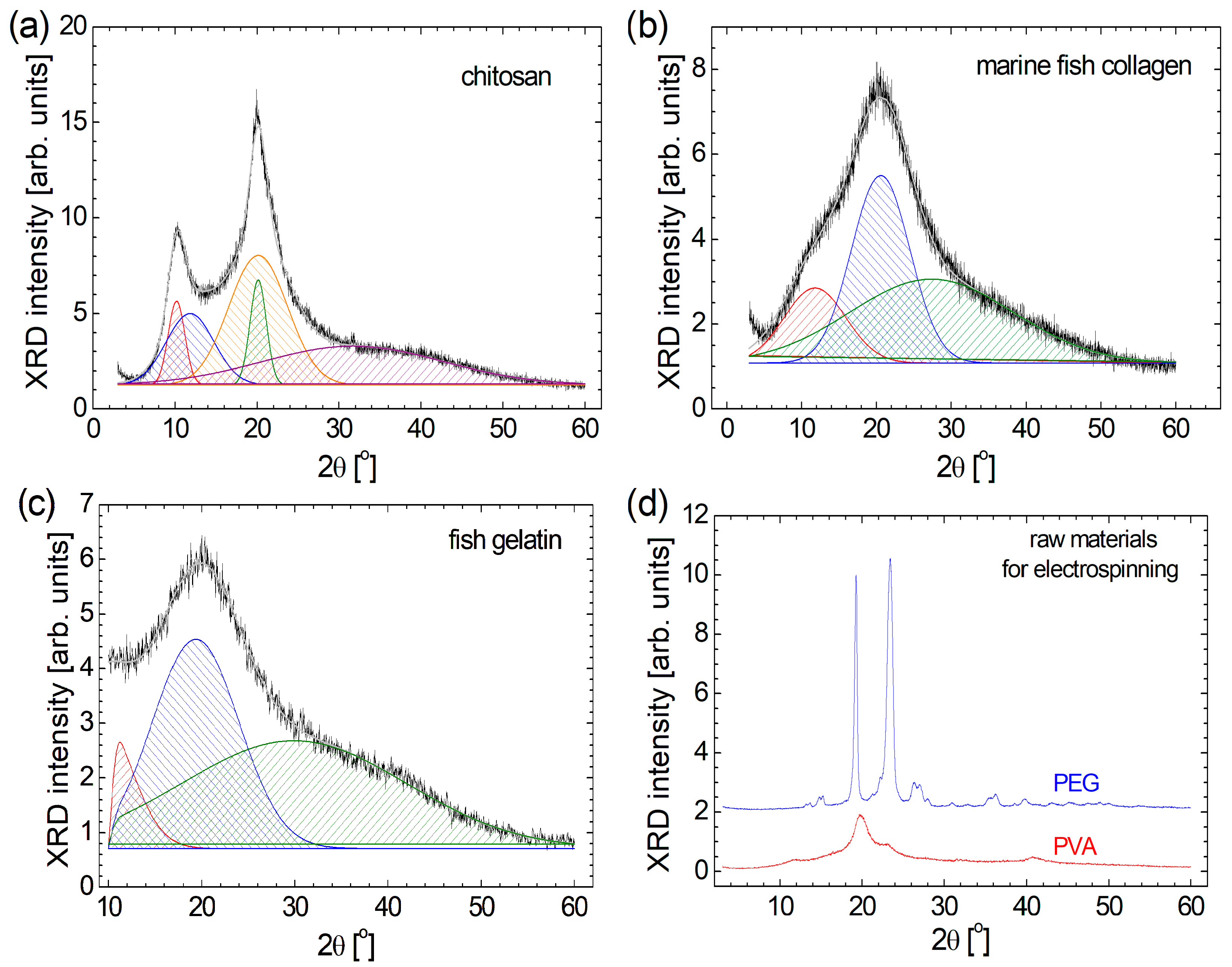
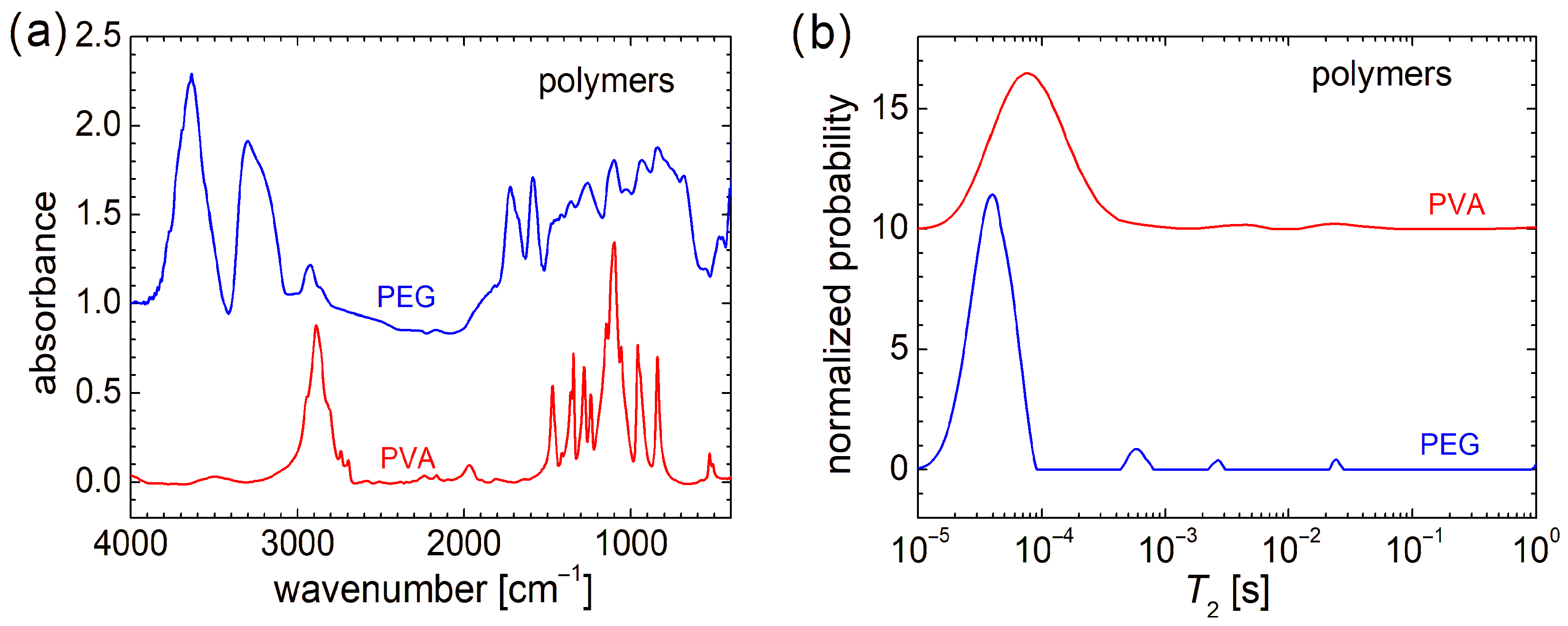
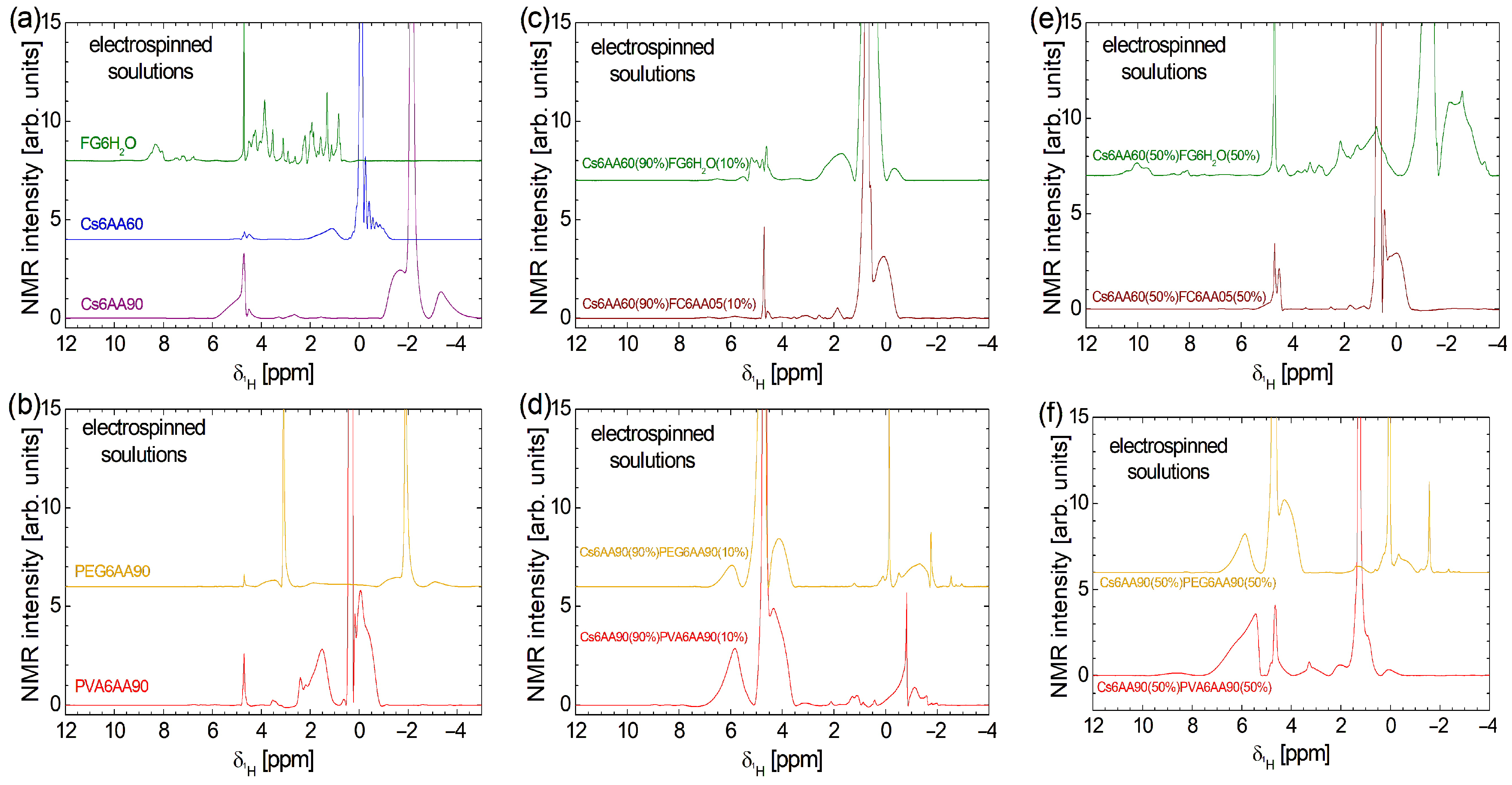
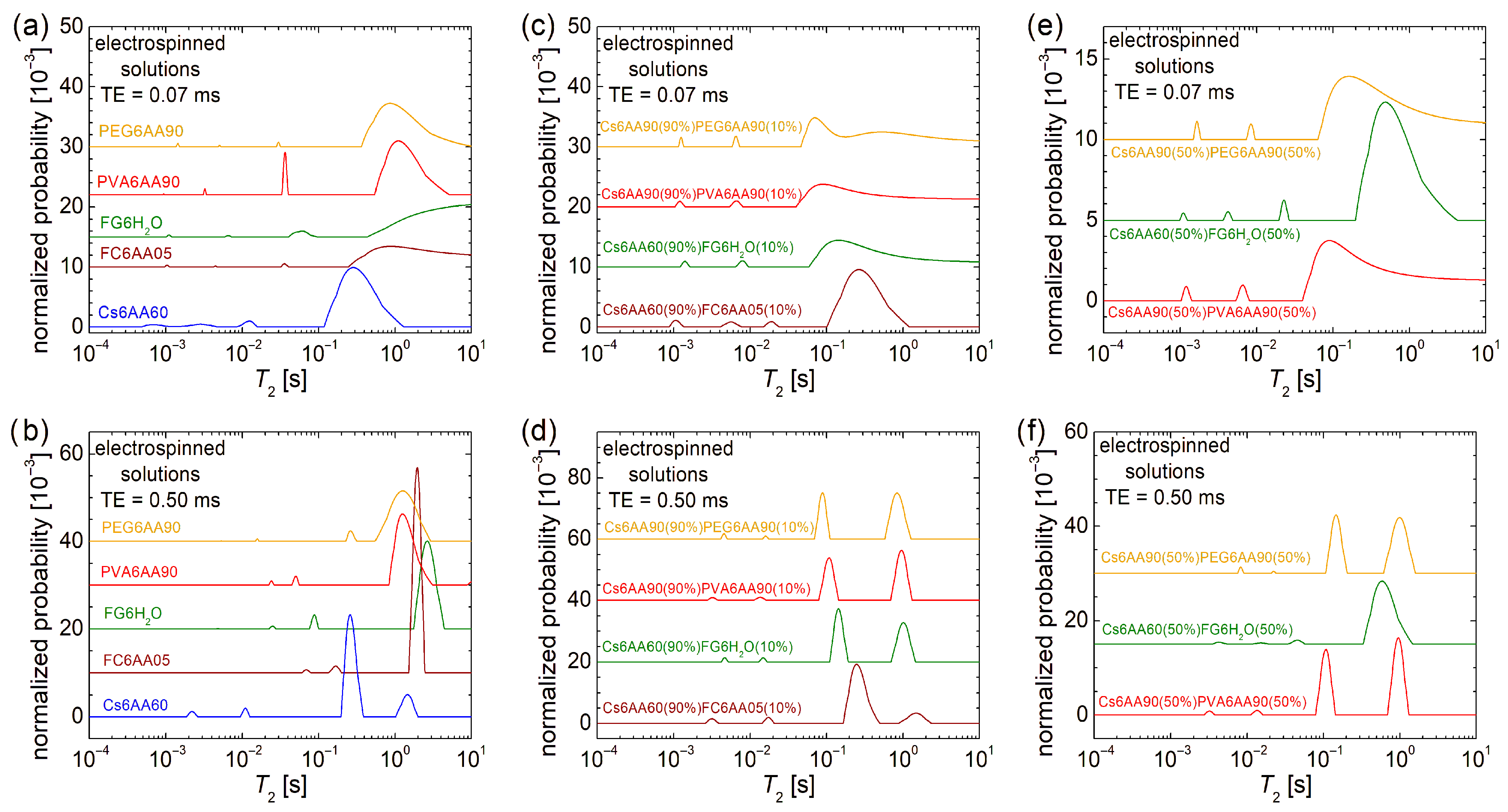


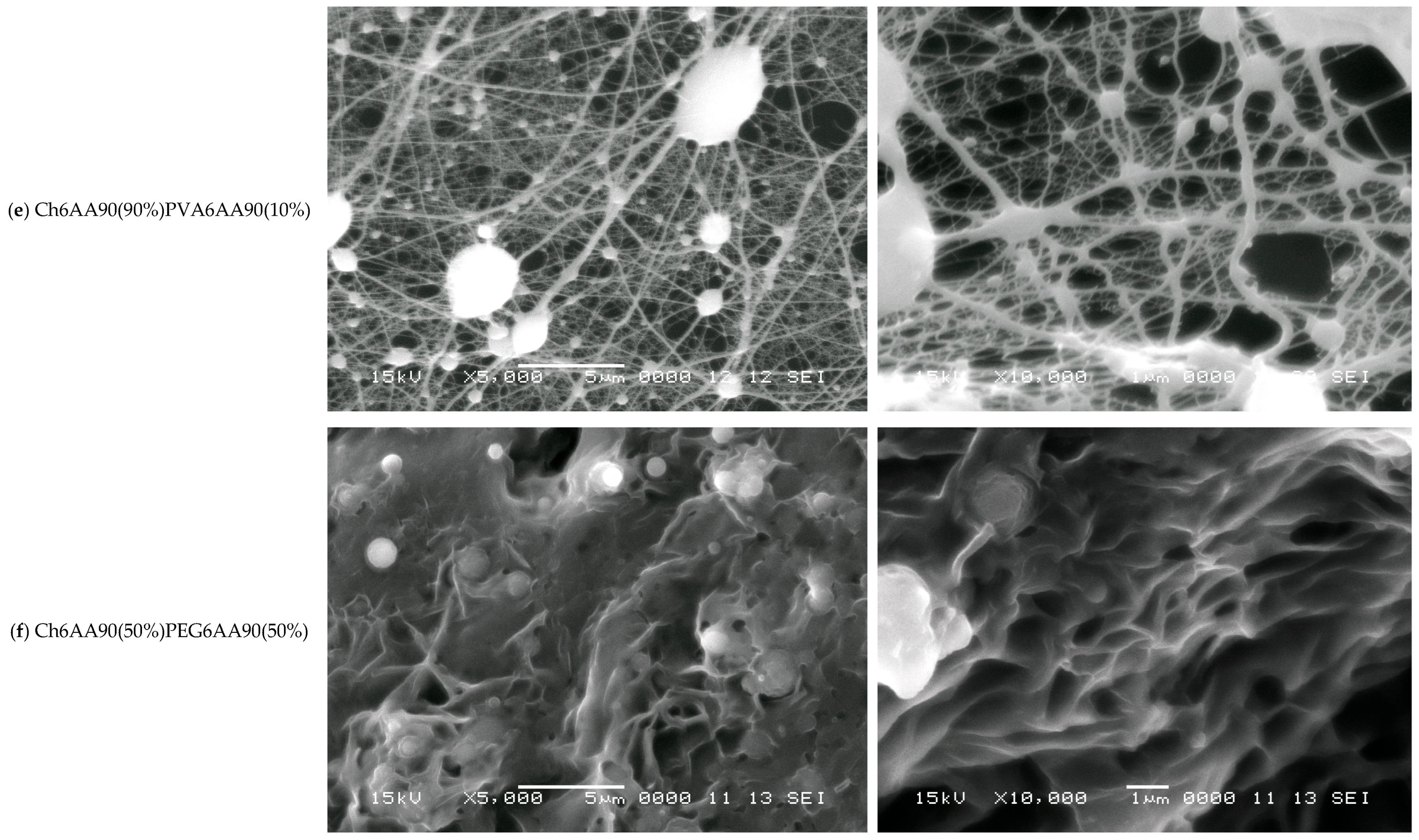


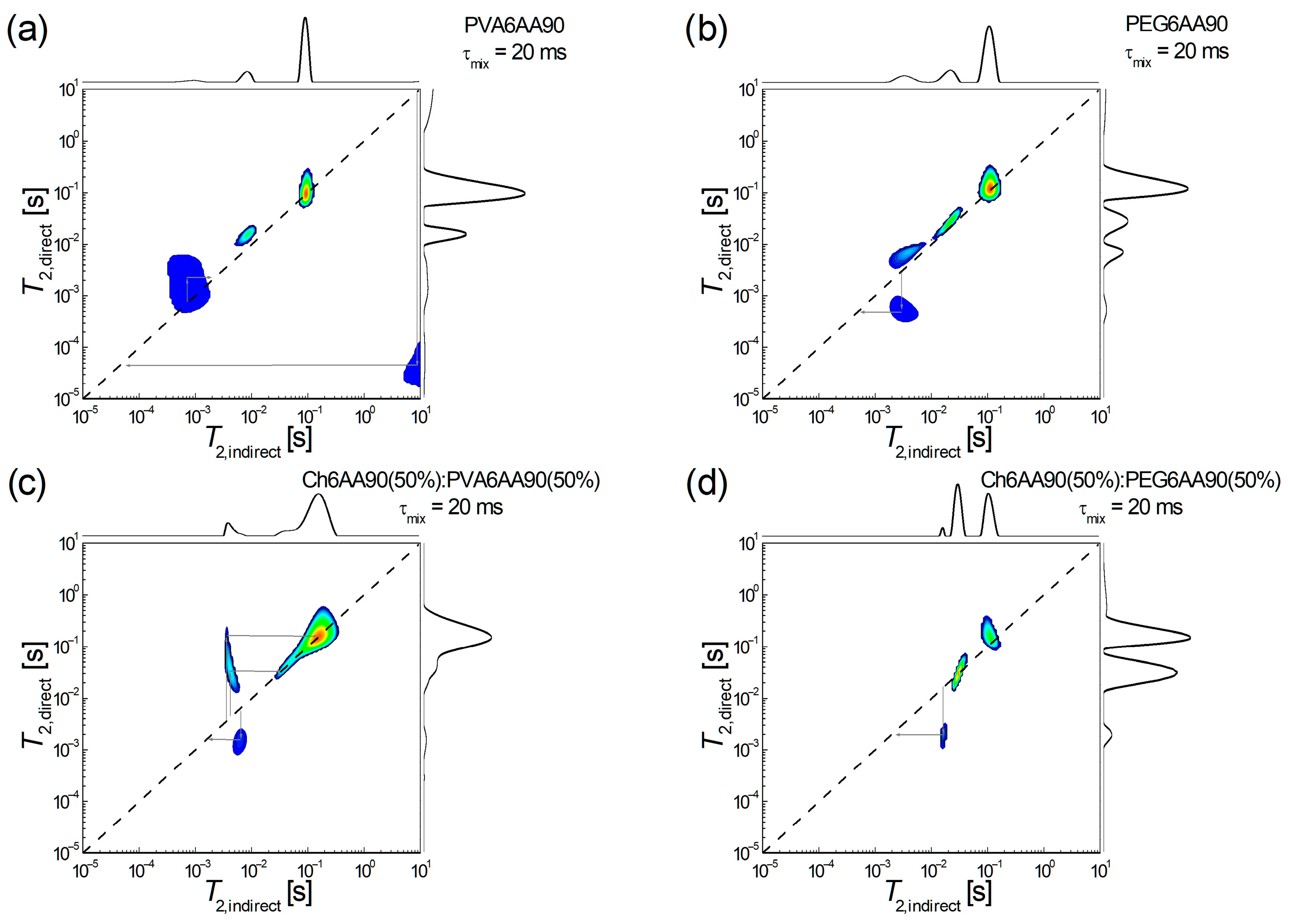


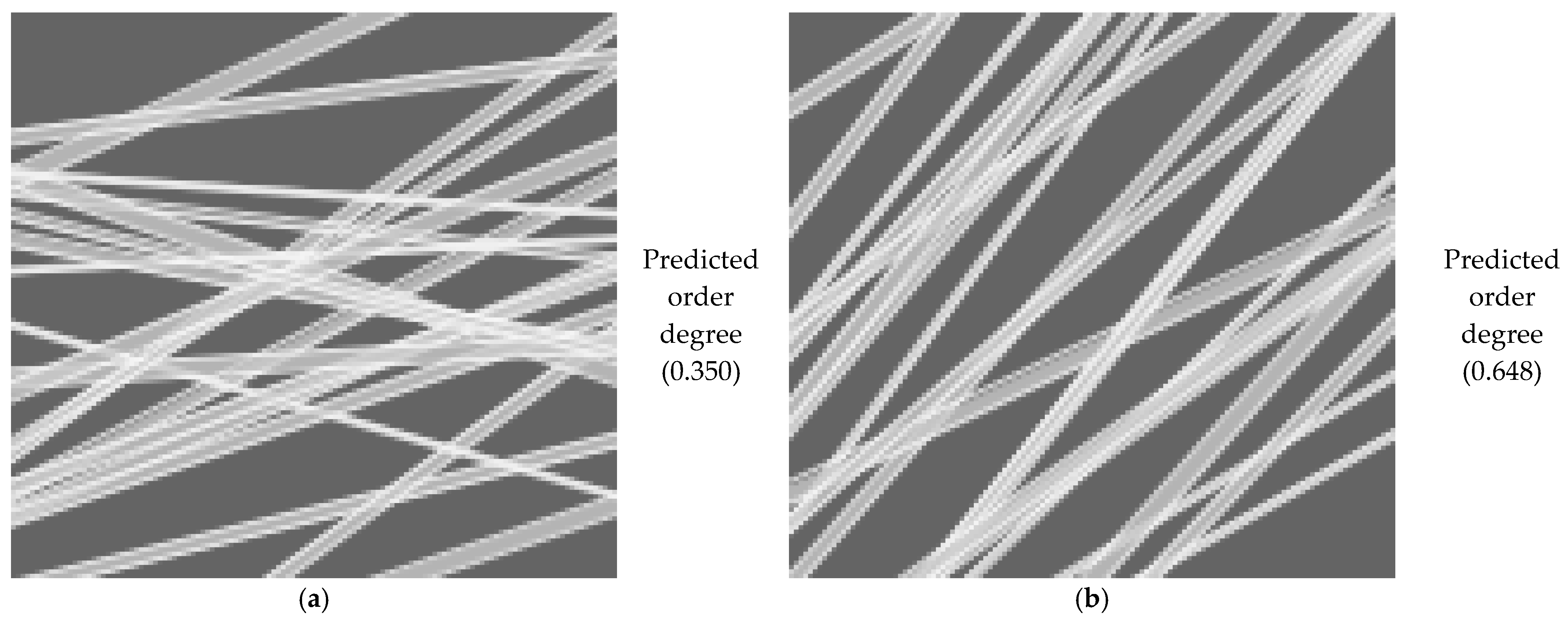
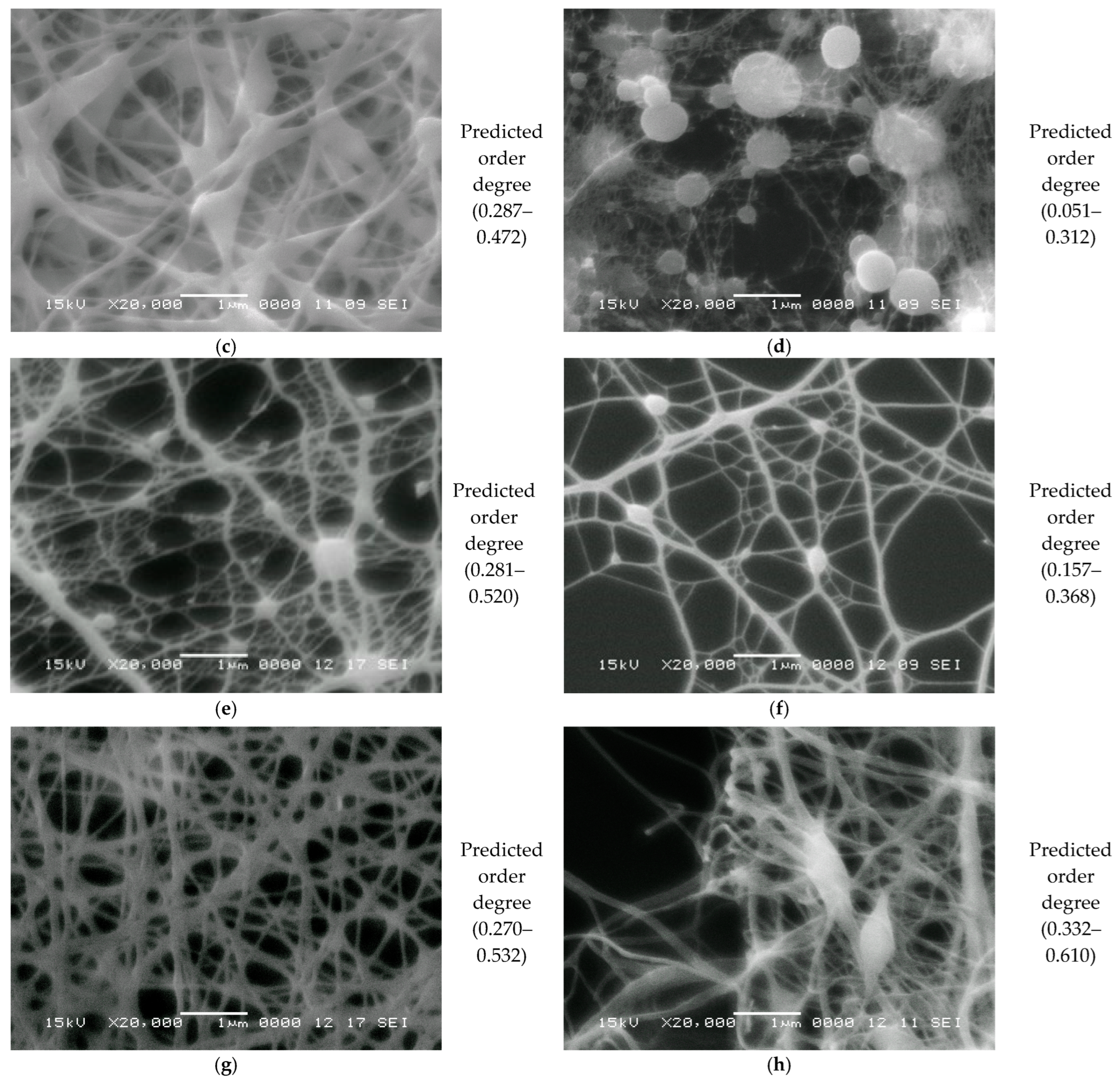
| Nomenclature of Dissolved Polymer Fractions Used for Electrospinning and Film Production | Dissolved Polymer Fraction 1 (Solution 1) | Dissolved Polymer Fraction 1 (Solution 2) | Fraction 1/Fraction 2 | ||
|---|---|---|---|---|---|
| Polymer 1 [%] | Solvent 1 [%] | Polymer 2 [%] | Solvent 2 [%] | ||
| Ch6AA60 | Chitosan 6% w/v | Acetic Acid 60% | - | - | 100/0 |
| Ch6AA90 | Chitosan 6% w/v | 90% Acetic Acid | - | - | 100/0 |
| Col6AA05 | Collagen 6% w/v | Acetic Acid 05% | - | - | 100/0 |
| Ch6AA90(90):Col6AA05(10) | Chitosan 6% w/v | 90% Acetic Acid | Collagen 6% w/v | Acetic Acid 05% | 90/10 |
| Ch6AA90(50):Col6AA05(50) | Chitosan 6% w/v | 90% Acetic Acid | Collagen 6% w/v | Acetic Acid 05% | layer1/layer2 |
| FG6H2O100 | Fish gelatin 6% w/v | H2O 100% | - | - | 100/0 |
| Ch6AA90(90):FG6H2O(10) | Chitosan 6% w/v | 90% Acetic Acid | Fish gelatin 6% w/v | H2O 100% | 90/10 |
| Ch6AA90(50):FG6H2O(50) | Chitosan 6% w/v | 90% Acetic Acid | Fish gelatin 6% w/v | H2O 100% | 50/50 |
| PVA6AA90 | PVA 6% w/v | 90% Acetic Acid | - | - | 100/0 |
| Ch6AA90(90):PVA6AA90(10) | Chitosan 6% w/v | 90% Acetic Acid | PVA 6% w/v | 90% Acetic Acid | 90/10 |
| Ch6AA90(50):PVA6AA90(50) | Chitosan 6% w/v | 90% Acetic Acid | PVA 6% w/v | 90% Acetic Acid | 50/50 |
| PEG6AA90 | PEG 6% w/v | 90% Acetic Acid | - | - | 100/0 |
| Ch6AA90(90):PEG6AA90(10) | Chitosan 6% w/v | 90% Acetic Acid | PEG 6% w/v | 90% Acetic Acid | 90/10 |
| Ch6AA90(50):PEG6AA90(50) | Chitosan 6% w/v | 90% Acetic Acid | PEG 6% w/v | 90% Acetic Acid | 50/50 |
Disclaimer/Publisher’s Note: The statements, opinions and data contained in all publications are solely those of the individual author(s) and contributor(s) and not of MDPI and/or the editor(s). MDPI and/or the editor(s) disclaim responsibility for any injury to people or property resulting from any ideas, methods, instructions or products referred to in the content. |
© 2025 by the authors. Licensee MDPI, Basel, Switzerland. This article is an open access article distributed under the terms and conditions of the Creative Commons Attribution (CC BY) license (https://creativecommons.org/licenses/by/4.0/).
Share and Cite
Crainic, R.; Pășcuță, P.; Popa, F.; Fechete, R. NMR, FT-IR, XRD, SEM, and ANN Complex Characterization of Some Nonwoven Materials Produced by Electrospinning. Materials 2025, 18, 4893. https://doi.org/10.3390/ma18214893
Crainic R, Pășcuță P, Popa F, Fechete R. NMR, FT-IR, XRD, SEM, and ANN Complex Characterization of Some Nonwoven Materials Produced by Electrospinning. Materials. 2025; 18(21):4893. https://doi.org/10.3390/ma18214893
Chicago/Turabian StyleCrainic, Ramona, Petru Pășcuță, Florin Popa, and Radu Fechete. 2025. "NMR, FT-IR, XRD, SEM, and ANN Complex Characterization of Some Nonwoven Materials Produced by Electrospinning" Materials 18, no. 21: 4893. https://doi.org/10.3390/ma18214893
APA StyleCrainic, R., Pășcuță, P., Popa, F., & Fechete, R. (2025). NMR, FT-IR, XRD, SEM, and ANN Complex Characterization of Some Nonwoven Materials Produced by Electrospinning. Materials, 18(21), 4893. https://doi.org/10.3390/ma18214893







